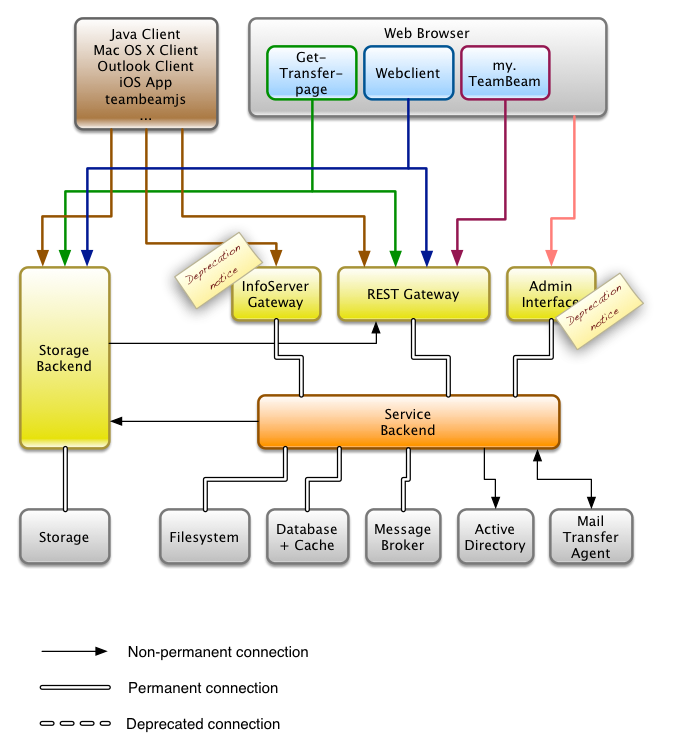Components
The TeamBeam service offering consists of several components:

Above: Overview of the interfaces and components
Clients
The service is typically used through clients which implement popular usecases.
My.TeamBeam
The My.TeamBeam portal is a single-page web application intended for human users. It is only available to registered Users, who must authenticate against the TeamBeam service backend. The following functionality is available:
- View the dashboard: A summary of the user's inbox and last actions. May also show contracts, and may allow the user to interact with them.
- List sent and received transfers.
- Launch or download one of the other clients.
- Manage the user's own profile and change the password.
- Access the administration frontend (requires admin privileges).
Webclient
The webclient allows users to send TeamBeam transfers from within a webbrowser. While generally any modern browser should work, the following browsers are supported:
- Internet Explorer 8, 9 (both are supported, but not recommended)
- Internet Explorer 10
- Microsoft Edge
- Chrome 32 and higher
- Firefox 4 and higher
- Safari 5 and higher
- Opera 9 and higher
For person-to-person transfers, the webclient requires an authenticated session. Typically this is established within the My.TeamBeam portal. Uploads to TeamBeam mailboxes do not require to be authenticated.
Theoretically there are no limitations in the size of the transfer payload when using the webclient, however older browsers may have issues when accessing files larger than 2GiB.
Get-Transfer-page
When opening the URL from a transfer notification email, the get-transfer-page is shown. It provides information about the details of the transfer and allows users to download files. If an authenticated session exists, the get-transfer-page is rendered within the My.TeamBeam portal. In this case, the user has access to additional actions, such as extending the duration of the transfer or forwarding it to another recipient.
The Get-transfer-page is dynamically created within a browser using JavaScript.
Java Client
As an alternative to the Webclient, Java-capable desktops can use a standalone client to initiate transfers. It requires valid user credentials and can only be used in an authenticated way.
Compared to the Webclient, its main advantages are:
- Support for upload-resume: In the case of a network outage, the Java client will attempt to reconnect and continue an upload from where it got interrupted previously. This is particularly handy when uploading large files over an unreliable network.
- Pause-and-resume: Similarly, it is possible to pause an upload and resume it at a later stage again (within 24h). It is quite acceptable that the network connection changes during the pause.
- Limit upload speed: It is possible to limit the maximum bandwidth to be used during an upload.
- Access to native addressbook: The Java client can access MS Outlook and Apple Contacts.
The Java client requires a JavaSE runtime version 1.5 or later. JavaSE version 8 is recommended.
The Java client is distributed via Java Web Start: teambeam.jnlp. This allows it to be updated automatically when a new version is published.
Mac OS X Client
The Mac OS X client has the same featureset as the Java client, however it does not require Java. It is distributed via the Apple OS X App Store: TeamBeam.app
The Mac OS X client requires Mac OS X 10.9 or later.
Outlook Client
The Outlook client is an extension that administrators can deploy into Microsoft Outlook. It monitors emails created in Outlook and converts them into TeamBeam transfers if a configurable size is exceeded. The Outlook client is also available as MSI file on request and can be deployed through a group policy object inside Active Directory. It is also possible to predefine some windows registry values used by the Outlook client by a group policy. We provide such documentation on request.
Warning
Requirements are unclear
iOS Client
This client is available to Apple iOS devices by the Apple App store and allows users to initiate TeamBeam transfers from their mobile devices.
Android Client
This client is available to Android devices by the Google Play store and allows users to initiate TeamBeam transfers from their mobile devices.